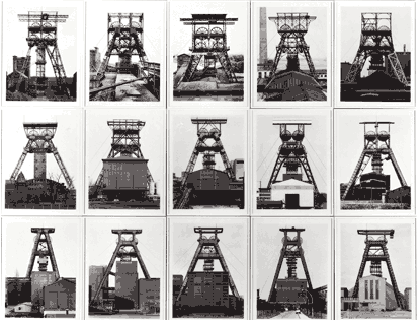The Düsseldorf Academy was founded in 1773 by the Elector Palatine Carl Theodor than Electoral Academy of painting, sculpture and architecture. Between 1819 and 1859 the academy under Peter von Cornelius and Wilhelm von Schadow developed the Dusseldorf school of painting.
The work of the art school was defamed and blackened during the post during the Degenerate art campaign brought about by the Nazi party on their election in 1933, the use of photography under the nazi party was mainly for propaganda. All Photography was strictly censored, and the heart fell out of German photography. In the 1950's and 1960's the academy once again regained its importance as a well respected centre of education and art. Photographers at the time borne our of post WW2, were keen to look forward as photographers, never looking back because of the history gone before them.
The 1976 Bernd Becher attended the Dusseldorf Academy, later Becher and his wife Hilla went on to form the Dusseldorf School of Photography. Again like the predecessors of the Neue Sachlichkeit and Neue Sehen, they wanted to produce objective photographic art, realism.
Bernd and Hilla Bechers photography always takes the same format, they either measure 30 x 40 cm or 50 x 60 cm and depict industry, be this buildings or machinery. Some of their typologies include Gasometers, blast furnaces and lime kilns to name a few of their bodies of work.
The Bechers used to wait unit they had the exact same weather conditions, they would carefully examine the site and would ensure the same distances and ensure the item being photographer filled the frame at the exact same difference as all the other images within the body of work. All external disruptions of distractions are avoided to ensure the viewer sees only the aesthetic of that which is being photographed. All their images are arranged as a typlogy and exhibited as a tableaux in the form of a grid (as above).
The Bechers work made the name of the Dusseldorf school in the 1970's as they where such prominent figures in the photographic world of this era. So in 1976 they started to teach photography at the Dusseldorf Academy and Bernt Becher took up the first professor of photographic art at any German academy. Their first students were:
"Staring out from the revival of documentary photography, of which the Bechers were such impressive masters, and against a backdrop of pictorial experimentation that transcended the medium, three generations of artists have now massively expanded the photographic vision and have advanced their creative art far into the realms of digital imagemaking. At the same time some have burst asunder the traditional restrictions on format and have moved beyond display cabinets to take over the walls of museums and art galleries." - Lothar Schirmer (Gronert 2009:7)
Bernd and Hilla Bechers photography always takes the same format, they either measure 30 x 40 cm or 50 x 60 cm and depict industry, be this buildings or machinery. Some of their typologies include Gasometers, blast furnaces and lime kilns to name a few of their bodies of work.
 |
| Winding Towers 1965-98 |
 |
| Gas Tanks |
 |
| Water Towers USA- 1988 |
The Bechers used to wait unit they had the exact same weather conditions, they would carefully examine the site and would ensure the same distances and ensure the item being photographer filled the frame at the exact same difference as all the other images within the body of work. All external disruptions of distractions are avoided to ensure the viewer sees only the aesthetic of that which is being photographed. All their images are arranged as a typlogy and exhibited as a tableaux in the form of a grid (as above).
The Bechers work made the name of the Dusseldorf school in the 1970's as they where such prominent figures in the photographic world of this era. So in 1976 they started to teach photography at the Dusseldorf Academy and Bernt Becher took up the first professor of photographic art at any German academy. Their first students were:
- Tata Ronkholz
- Volke Dohne
- Iris Salzmann
- Angelika Wengler
- Candida Hofer
- Axel Hutte
- Thomas Struth
- Thomas Ruff
"Staring out from the revival of documentary photography, of which the Bechers were such impressive masters, and against a backdrop of pictorial experimentation that transcended the medium, three generations of artists have now massively expanded the photographic vision and have advanced their creative art far into the realms of digital imagemaking. At the same time some have burst asunder the traditional restrictions on format and have moved beyond display cabinets to take over the walls of museums and art galleries." - Lothar Schirmer (Gronert 2009:7)
No comments:
Post a Comment